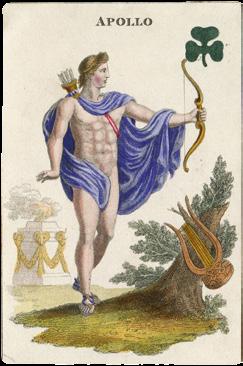
3 minute read
Starring François-Joseph Talma in the role of Nero
in ‘Britannicus’
The Maker
For a description of Conrad Ludwig Wüst, please see item 41.
The Cards
A series of celebrities from the early nineteenth century appear in the present deck, the majority of whom are figures from the stage. The doublefigure court cards show these actors, singers and dancers in a range of theatrical costumes, such as François-Joseph Talma, whom the deck is named after, in the role of Nero in the play ‘Britannicus’. Popular French operas such as ‘Le barbier de Seville’ and ‘Le calife de Bagdad’ are represented on the Jack of Clubs and the King of Diamonds. The only play that appears twice, on the Jack of Spades and Queen of Clubs, is ‘Robin Des Bois’ (Robin Hood). The Ace and pip cards are simply presented, with the number of suit marks corresponding to the value of each card. The deck is undoubtedly German in origin, but was also published by Antoine Dieudonné, from Grevenmacher in Luxembourg. Dieudonné copied German cards regularly but the quality of his decks were invariably inferior to the original editions.




HODGES, Charles [Celestial playing cards].
Publication
London, Stopforth & Son, 1827.
Description
52 engraved playing cards with fine original hand-colour, versos plain.
Dimensions
95 by 63mm (3.75 by 2.5 inches).
References
Hargrave p.179; van den Bergh pp.76-79; Yale 2283/ENG137.
The Maker
Charles Hodges operated as a stationer and bookseller from his shop at 27 Portman Street, London from 1825-1830. He was best known for his two decks of ornately engraved playing cards on the themes of geography and astronomy that appeared in 1827. These were among the last decks of engraved cards published in London, as chromolithography soon took over. They are thought to have been printed for Hodges by the firm of Stopforth & Son, which was also active in London during the early nineteenth century.
The Cards
The present cards are widely considered to form the most beautiful deck published in the nineteenth century. The gold print, detailed images and lively colours create a sense of luxury to match the heavenly subject matter. Each Ace card shows three signs of the zodiac corresponding to a certain season, labelled in Latin above the images. The same signs are also found on the Eight, Nine and Ten pip cards. On the Aces, the sigils surround their respective suit marks, although the Spades symbol is missing. The deck is therefore technically incomplete, meaning that it conveniently avoids being classified as a taxable good.
The court cards depict the divine figures of classical mythology, shown with their associated accoutrements:
King, Queen, Jack: Club – Apollo, Diana, Bacchus Diamond – Mars, Minerva,Vulcan Heart – Jupiter, Juno, Mercury Spade– Neptune,Venus, Saturn
The pip cards are equally as impressive, with each one displaying a constellation or mythological character. The value of the card corresponds to the number of suit marks shown, and even the symbols themselves are distinctive. Both of Hodges’ impressive decks are characterised by their elongated carmine Hearts, green trefoil Clubs, gold Diamonds and blue pike-head Spades.












HODGES, Charles [New royal playing cards].
Publication
London, Stopforth & Son, 1827.

Description
52 engraved playing cards with fine original hand-colour, versos plain.
Dimensions 95 by 63mm (3.75 by 2.5 inches).
References
Hargrave p.179; Van den Bergh pp.80-83; Yale 2253/ENG106.
The Maker For a description of Charles Hodges, please see item 44.
The Cards
In 1825, Parisian card-maker René Janet published a deck of cards entitled ‘Boston de l’Univers ou Jeu des Quatre Parties du Monde’ (‘Boston [cards] of the Universe, or Game of the Four Parts of the World’). Each suit in this deck represented a continent: Hearts for Europe, Spades for America, Diamonds for Asia and Clubs for Africa. Two years later, Charles Hodges appropriated Janet’s concept and produced his ‘New Royal Playing Cards, Patronised by His Majesty’.
Hodges’ deck far outshone Janet’s in both beauty and popularity, and is widely held as the most beautiful set of geographical playing cards ever made. Each Ace shows a general map of the continent represented by that suit, simply but effectively outlined in colour. Similarly, the pip cards show national maps of significant countries in each continent, their value corresponding to the number of suit marks displayed. Even the symbols themselves are attractively designed, with elongated carmine Hearts, green trefoil Clubs, gold Diamonds and blue pike-head Spades. The court cards each depict a full length figure, representing either a native of their continent or a historical personage closely associated with it:
King, Queen, Jack: Club – Saladin, Zulema of Algiers, Moroab of Morocco
Diamond – Kien Long, Statire of Persia, Hyder Ali of Mysore Heart – George IV, Catherine II of Russia, Robespierre Spade– George Washington, Neala of Canada, Telasco of Mexico
Not all of these figures had appeared on the original deck by Janet, and Hodges’ most notable addition is certainly that of Robespierre. In the decades after his ousting from power and ironic execution at the guillotine, the legacy of the French revolutionary fluctuated continually, making it difficult to tell whether his representation as the Jack of Hearts is designed as a celebration or condemnation of his memory.












[ANONYMOUS]
[Four Seasons playing cards].
Publication [Germany, c1830].
Description
52 engraved playing cards with fine original hand-colour, blue printed pattern to versos.
Dimensions
86 by 600mm (3.5 by 23.5 inches).
References Van den Bergh p.240.



